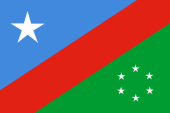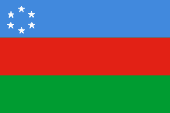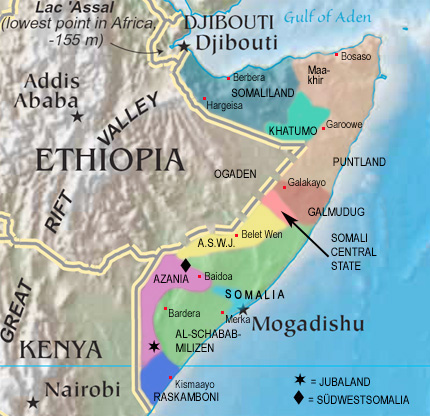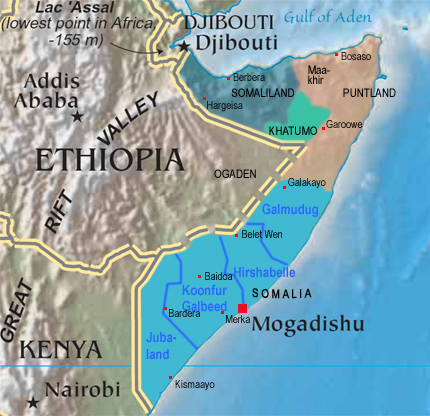Südwestsomalia |
|
|
|
| Übersicht – Contents: | |
Südwestsomalia |
|
|
|
| Übersicht – Contents: | |
Flagge – Flag: |
|
 |
seit/since 2014, |
historische Flagge – historical Flag: |
|
 |
2002–2006, |
| Die heutige Flagge von Südwestsomalia ist durch einen roten Diagonalbalken zwischen Hellblau und Grün geteilt, im hellblauen Feld erscheint ein Stern und im grünen ein Kreis aus sechs weißen Sternen. Die zwischen 2002 und 2006 genutzte Flagge zeigte drei horizontale Streifen in Somalia-Hellblau, Rot und Grün. Im blauen Streifen befand sich nahe am Mast ein Ring aus sechs Sternen. Sie könnten für die sechs Südprovinzen Somalias stehen, die einst zu Südwestsomalia gehören sollten. |
The today's flag of Southwest Somalia is divided by a red diagonal stripe between light blue and
green, a star appears in the light blue field and a circle of six white
stars in the green field. The flag used between 2002 and 2006 featured three horizontal stripes in Somalia light blue, red and green. In the blue stripe was placed near the pole a ring of six stars. They could stand for the six southern provinces of Somalia which once should belong to Southwest Somalia. |
| Zur Bedeutung der Farben ist nichts bekannt, wobei die Verwendung des Somalia-Hellblau auf die bisherige Somalische Symbolik zurückgeht. Die Farben Rot und Grün sind offenbar von zentraler Bedeutung für das somalische Volk, denn die Farben tauchen auf Somalischen Flaggen immer wieder auf (Somaliland, Ogaden, WSLF, SPM Jubaland). Grün steht sicherlich für den Islam. | About the
meaning of the colours is nothing known, but the using of the pale blue of
Somalia goes back to the hitherto Somali symbolism. The colours red and green are obviously from pivotal significance for the Somali people, because the colours arise on Somali flags again and again (Somaliland, Ogaden, WSLF, SPM Jubaland). Green stands certainly for the Islam. |
| Quelle/Source: Volker Preuß | |
| interaktive Landkarte – interactive Map: |
Das Horn von Afrika, 2012 – The Horn of Africa, 2012: Quelle/Source: Freeware, University of Texas Libraries, modyfied by: Volker Preuß |
Das Horn von Afrika, 2023 – The Horn of Africa, 2023 Quelle/Source: Freeware, University of Texas Libraries, modyfied by: Volker Preuß |
| Zahlen und Fakten – Numbers and Facts: | |
|
|
|
|
|
|
|
|
|
|
|
|
|
|
|
|
| Der Staat Südwestsomalia wurde im April 2002 durch Oberst Hassan Mohammed Nur Shatigadud von der Rahanweyn Resistance Army (RRA) ausgerufen. Die Rahanweyn sind ein Clan, der hauptsächlich in der Provinz Baidoa und der nördlich davon gelegenen Provinz Bakol lebt. Südwestsomalia beanspruchte immerhin alle sechs Südprovinzen von Somalia (einschließlich Jubaland), jedoch residierte Präsident Mohammed Nur ausschließlich in Baidoa, und wurde sogar noch in 2002 kurzzeitig aus Baidoa vertrieben. Jubaland verblieb unter der Kontrolle der JVA-Miliz. Im Jahre 2003 übernahm Ibrahim Habsade – der Vizechef der RRA – die Macht in Südwestsomalia. Im Jahre 2005 floh die somalische Zentralregierung nach Baidoa und vertrieb die RRA. Damit endete die kurze Geschichte Südwestsomalias. Im September 2006 wurde Baidoa von Truppen der radikalislamischen "Union islamischer Gerichte" erobert, und im Dezember 2006 von Truppen Äthiopiens und Somalias besetzt. Unter wechselnder Führung und mit immer wieder wechselnden Flaggen gelang es den Südweststaat als politisches Projekt am leben zu halten, was darin gipfelte, das der Staat im Jahre 2014 ein föderaler Teilstaat der neu proklamierten Bundesrepublik Somalia wurde (somalischer Name: Koonfur Galbeed). |
| siehe auch: Geschichte von Somalia (← hier klicken) |
| The State of Southwest Somalia was proclaimed in April 2002 by Colonel Hassan Mohammed Nur Shatigadud from the Rahanweyn Resistance Army (RRA). The Rahanweyn are a Clan which primary lives in the provinze of Baidoa and in the northern situated provinze of Bakol. Southwest Somalia demanded nevertheless all six southern provinces of Somalia (including Jubaland), but President Mohammed Nur resided solely in Baidoa, and was even still in 2002 momentary exiled from Baidoa. Jubaland remained under the control of the JVA militia. In 2003 Ibrahim Habsade – the vice chief of the RRA – seized the power in Southwest Somalia. In the year 2005 fled the Somali central government to Baidoa and banished the RRA. In this way ended the short history of Southwest Somalia. In September 2006 Baidoa was conquered by troops of the radical-islamic "Union of Islamic Courts" and became occupied in December 2006 by troops of Ethiopia and Somalia. Under changing leadership and with ever-changing flags, South West State managed to keep alive as a political project, culminating in the state becoming a federal constituent state of the newly proclaimed Federal Republic of Somalia in 2014 (Somali name: Koonfur Galbeed). |
| look also: History of Somalia (← click here) |
|
Quelle/Source: Volker Preuß, World Statesmen, Wikipedia (EN) |